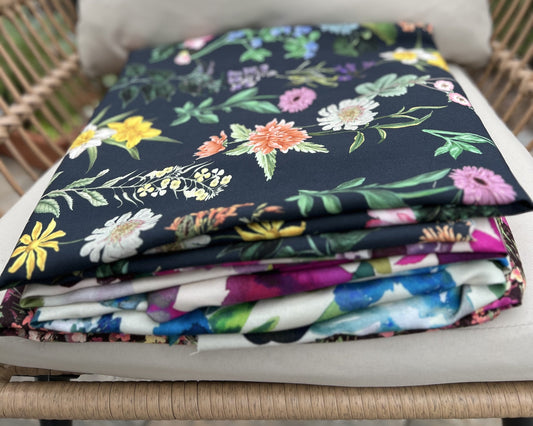This article will be a kind of pilot for a series on wool, so it seems natural that it should allay those doubts, uncertainties and fears that arise when you first think of sewing with wool.
The top 5 reactions from people who have yet to get to know and love wool are:
-
"It bites!"
-
"It can't be washed!"
-
"The moths will eat!"
-
"It's only for winter."
-
"It's for a jumper."
Thus.
"Wool? It bites!"
This is a large generalisation, as they 'bite' wool varieties with high coarseness and coarse hair. Sheep come in a multitude of varieties that differ not only in appearance but also in fleece type. It is impossible not to mention fine merino, which has soft and fine hair with excellent thermal performance. When looking for the right knit or woollen fabric, we need to determine our needs and requirements. For garments intended for constant contact with the body and more specifically with the skin (especially children's skin), merino wool (also known as merino) is the best choice, as it is the softest sheep's wool. Merino sheep varieties, and even individual animals, differ in hair quality, so we will also find finer and less fine wools among them. For outer garments or lined garments, wool with lower hair qualities may be tempting, so do not rule out less fine wools.
Here we have room for a good fabric retailer to suggest the right material depending on expectations and application.
An allergy to sheep's wool, or more precisely to the lanolin contained in it, which can result in skin irritation even with the finest sheep's wool yarn, deserves a brief mention here. In this case, it is worth looking for an alternative, which often turns out to be cashmere,
i.e. the wool of a particular variety of goat or alpaca wool. Both fibres have negligible amounts of lanolin in them.
And finally - let's love biting the wool. Rough wool massages the skin, improving blood circulation and thus nourishing and conditioning the skin. Let's give slightly biting wool a chance. Our skin becomes very accustomed to the stimuli it constantly receives. Who among us remembers the once popular massaging flip-flops with tabs?
Something that at first resembled walking on gravel became a pleasant massage.
"Wool? It can't be washed!"
Often, ready-to-wear woollen garments and especially outer garments have dry cleaning in the care recipe. In this way, manufacturers often protect themselves somewhat exaggeratedly against potential complaints resulting from improper care of the garment.
When sewing on our own, we have more scope. We can use wool with the now common 'superwash' finish for sewing or be tempted to test purchased material. To do this, cut a piece of fabric at least 10×10 cm in size and wash it. And after it has dried completely, we check if its size or quality has changed. If the wool has retained its size and structure, the garment can be successfully washed.
Wool should be washed by hand or on a woollen programme (here it is best to test your washing machine first) using a detergent designed for this purpose (wool should not be washed in standard washing powders/liquids/capsules!).
We often dread the recommended hand washing, but completely unnecessarily. Hand-washing wool involves soaking it in water with wool detergent, then gently wrinkling it, rinsing it, squeezing (not wringing!) out excess water and letting it dry. The process is essentially low-impact, and given that wool is anti-static, so does not attract dust and absorbs dirt poorly, as well as not absorbing odours, we wash wool garments less frequently than other garments. We also don't have to fear the lack of spinning or wringing, as wool dries faster than other natural materials (cotton, linen, viscose).
"Wool? Moths will eat it!"
Wool garments are extremely durable and, unlike cotton, age slowly and will not fade, fade or grey. Wool's only opponent is moths (less commonly shubak). However, it is possible to successfully protect our wool from moths, and our grandmothers and great-grandmothers excelled at this and used the same woollen garments for years.
Clothes moths are sensitive insects, they do not like ventilation, sunshine or strong smells. Woollen clothes should therefore not be stored in stuffy places, the wardrobe should be aired regularly and woollen clothes should be taken out and aired on sunny days. A good practice is to wipe the inside of the wardrobe with vinegar and water at the same time. Store wool in the company of intense scents. It is not only lavender that is an opponent of moths. In addition to lavender, we can also use laurel, mint or patchouli, or even the once common marshmallow herb. The effectiveness of naphthalene, which was popular not so long ago, cannot be denied, but it leaves an unpleasant smell, which seems to repel people as effectively as pests. Placing a strong-smelling bar of soap among woollen clothes is also a popular and effective method.
Of course, manufacturers of insect repellents have not been indifferent to the problem of wool pests and offer hangers or cartons that not only repel, but also kill moths. So we have a choice between natural and chemical means.
I would like to raise awareness of the use of moth traps. Do not use them as a preventative measure! They have pheromones which attract moths even from further away. If such a trap is left in place for a longer period of time, moths will feel invited and any ventilation grilles or open windows will be like an open door to the best restaurant.
We use traps in two cases:
-
When we want to check if we have a moth infestation. Close the windows, secure the air vents and leave the trap in the place where moths are expected for a day or two. Then remove the trap immediately!
-
When we are sure we have a moth infestation and as a back-up to other methods we want to quickly reduce the number of moths in the flat. Also, we secure the vents and try to avoid prolonged ventilation as long as we use a trap.
"Wool? It's only for winter."
Wool is the undisputed queen of winter, as it warms us by using our body heat. It is a "living" fibre which, like our hair, reacts to the humidity and temperature of its surroundings. This miracle of nature, thanks to its specific structure, retains air cushions that insulate us from the ambient temperature, whether it is high or low. I will use a simple comparison with double-layered windows, which, thanks to the air layer enclosed between the panes, provide excellent protection against heat loss in winter and against the heat outside in summer. Of course, we are not talking about a situation in which the sun comes through the window and heats up the room, because a window, unlike wool, is a poor barrier to the sun's rays. Wool, on the other hand, has a natural UV filter, with merino wool leading the way, boasting a UPF of over 50 (this means that for every 50 units of light that reach the wool, it will only let through a maximum of 1 unit, i.e. stopping a minimum of 98% of both UVA and UVB radiation). Most ordinary clothing has a UPF of 6 (according to US magazine Consumer Reports).
Wool absorbs and evaporates water wonderfully at the same time, so we don't have to be afraid of the poignant chill of rainy mornings or the 'burn' in sweaty clothing when the skin is just begging for air.
"Wool? It's only for a jumper."
Many people still picture yarn when they hear the word 'wool', and although wool-rich yarns are the top of the wool world, more of the world's sheep fleece production goes to fabric and knitwear manufacturers and then to sewing rooms or under our home sewing machines. Wool is not just yarn, but also wool fabrics and wool knitwear. It is not only woollen jumpers, it is also the best woollen suits, woollen thermal clothing, woollen children's clothes, woollen dresses, woollen shirts or high-end wool skirts and woollen garments from the world's fashion catwalks.
If I managed to get you interested in wool with this first article, then surely this series will become an interesting journey into the world of this remarkable fibre.
Author: Kamila Muszarska-Iwaniczko

![Wool. The Beginning. [english version]](http://woolstock.fr/cdn/shop/articles/dzianina-welniana-merino-blog.jpg?v=1671043318&width=1100)


